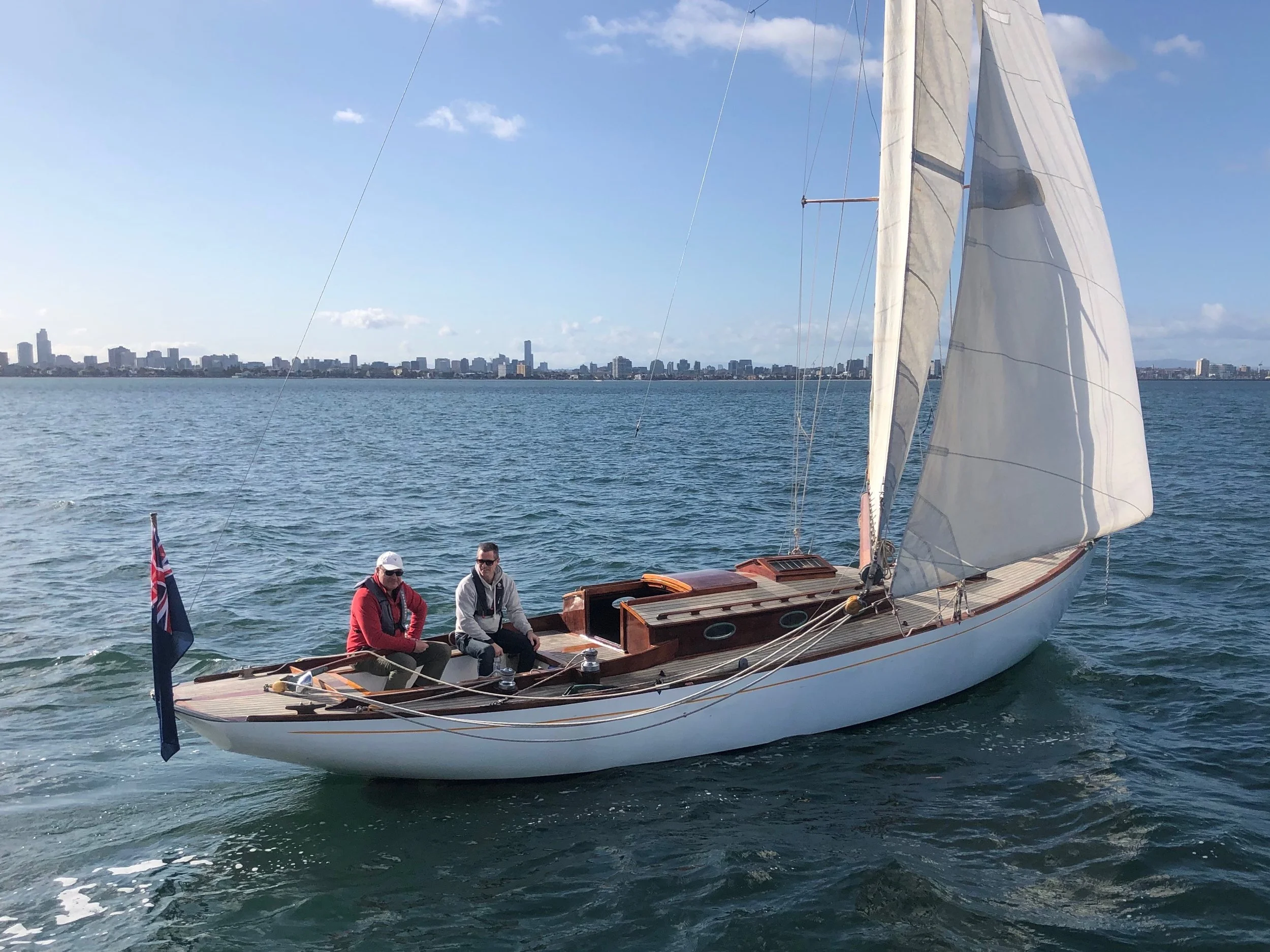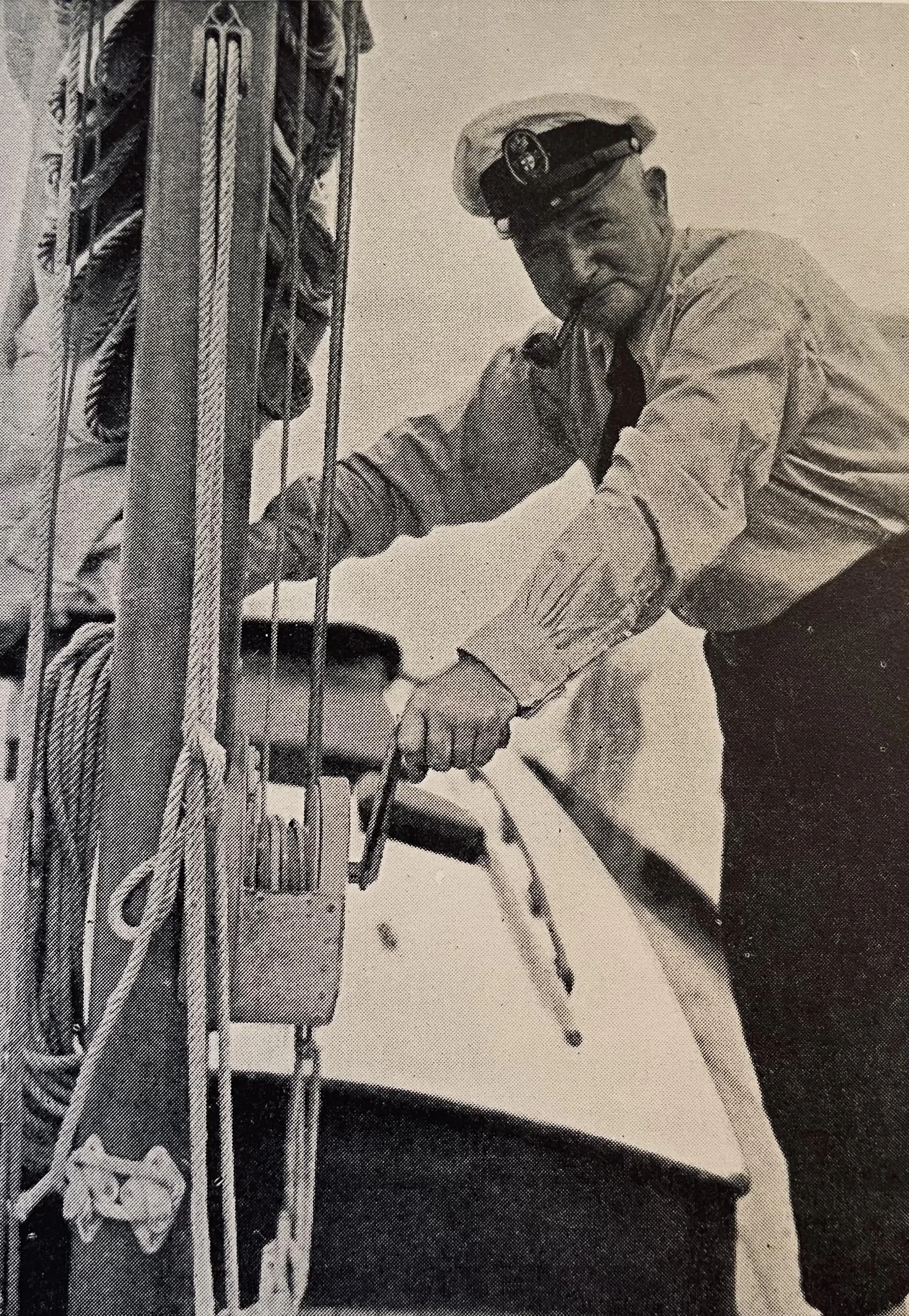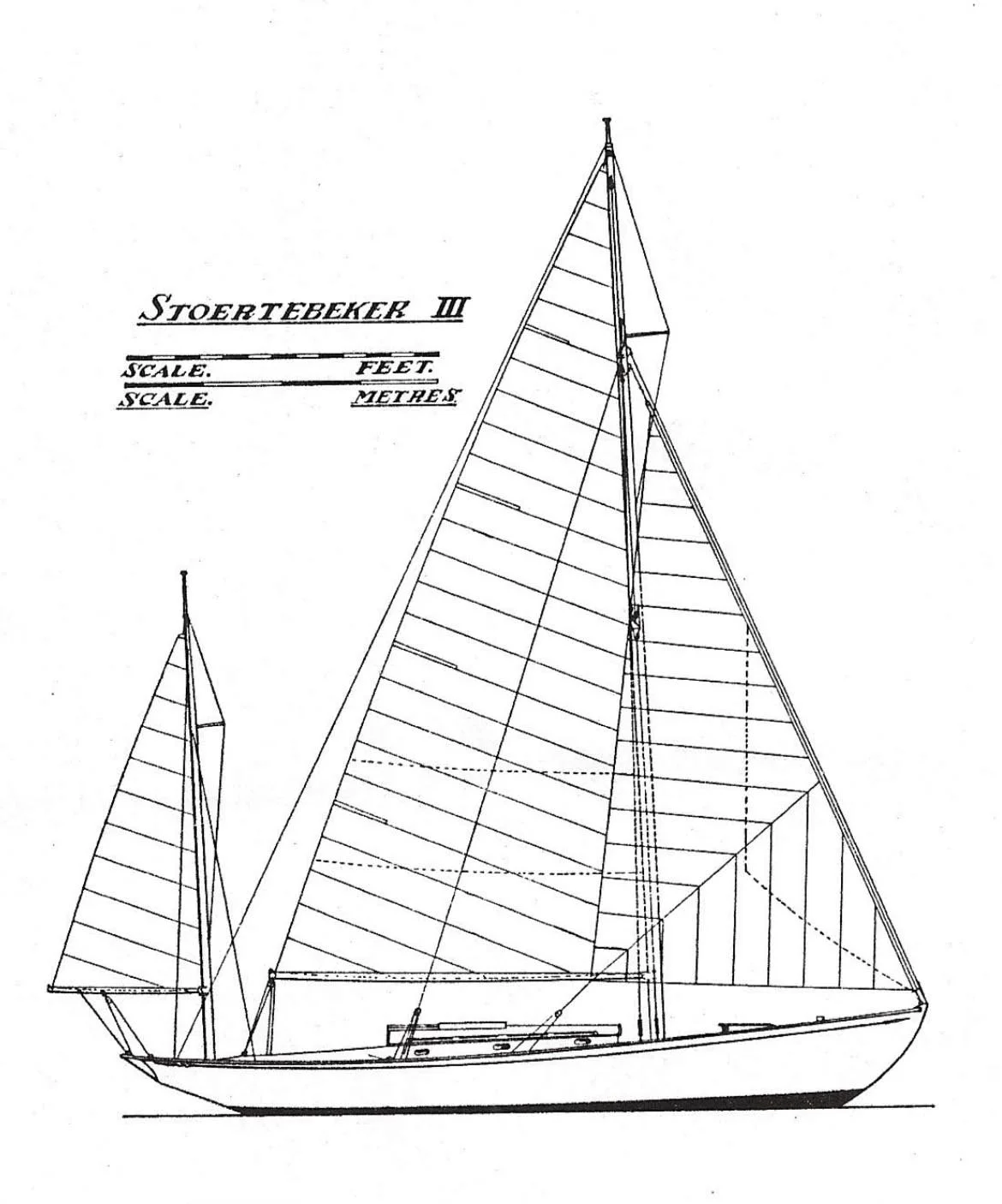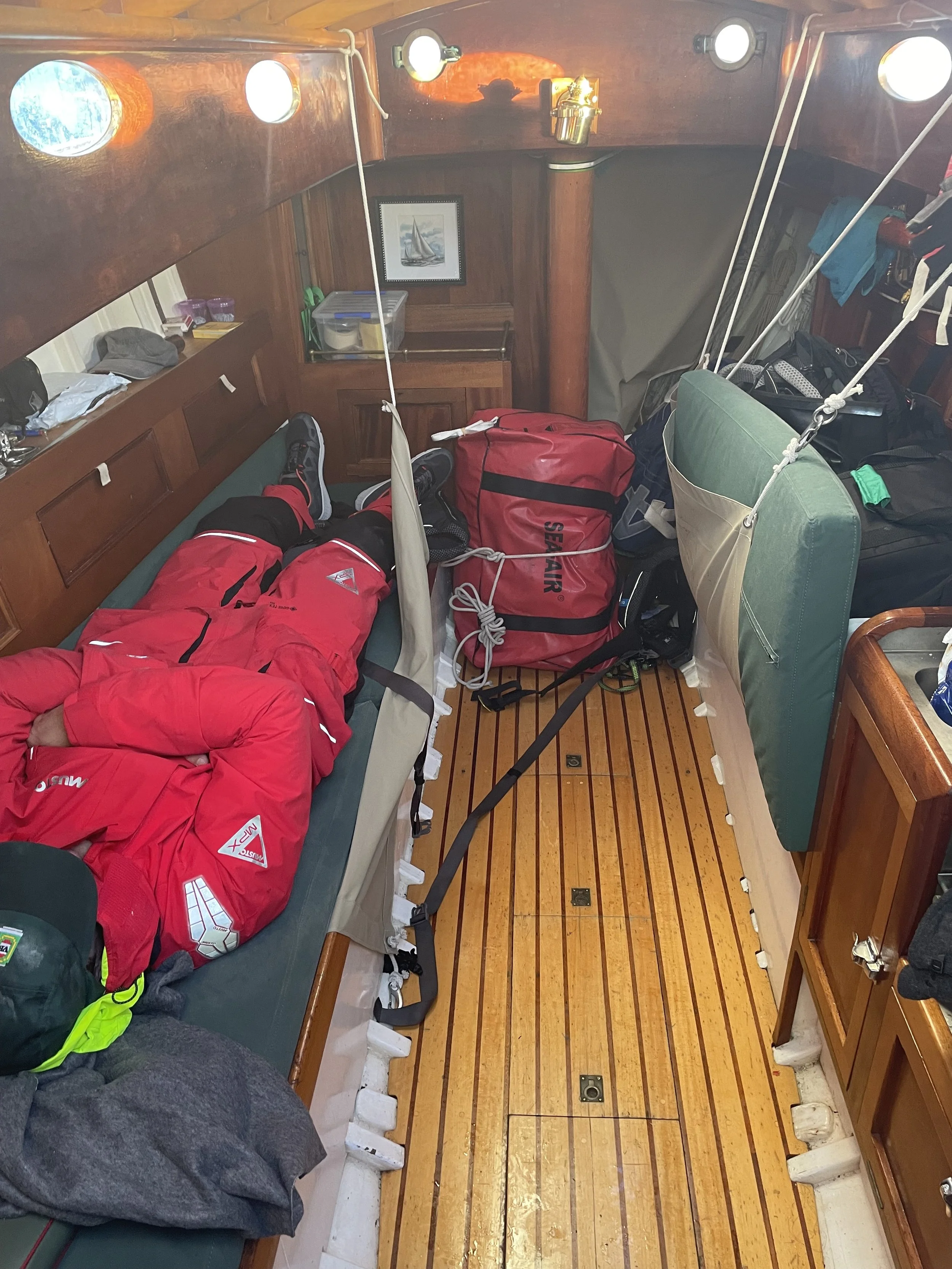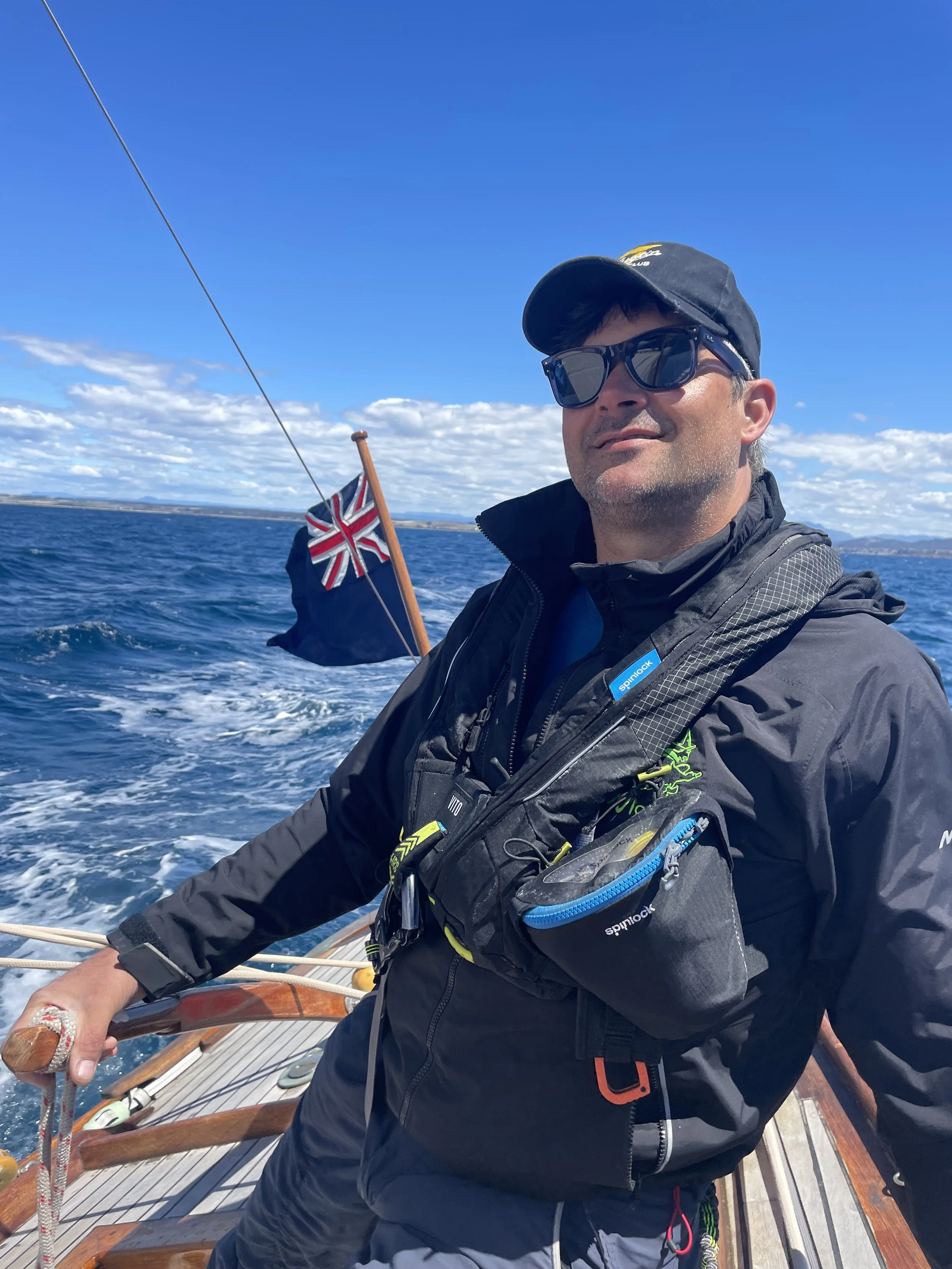TANDANYA’s Dash to Devonport
Retracing the 1946 Melbourne to Devonport Race in an 84 year old wooden boat
By Romauld Andrew and James Waters
In December 1946 five yachts crossed the start line at Queenscliff, near the entrance of Port Phillip Bay, for the Melbourne to Devonport Race, the first after the war. One of the yachts was the auxiliary yawl TANDANYA, then owned by Tom Clarke, Vice Commodore of the Royal Yacht Club of Victoria. This can be an arduous race because it entails crossing Bass Strait, a notoriously fickle stretch of water.
In 2023 it was decided to re-enact this by sailing TANDANYA from Queenscliff to Devonport and back to Queenscliff in the week before Christmas, 2023.
TANDANYA is entering her 85th year and has been a part of the Classic Yacht Association of Australia fleet in the northern waters of Port Phillip Bay, for the last 20-odd years. The story of the boat has its origins in a German boat, STORTEBECKER III
STORTEBECKER III
STORTEBECKER III was designed as an ocean cruising yacht, to be sailed single handed across the Atlantic by a retired merchant seaman, Captain Ludwig Schlimbach. This was intended to be a promotional cruise, part of Abeking & Rasmussen’s marketing in the US where their boats were popular.
Schlimbach was well known to the leading members of the Cruising Club of America. In 1931 he sailed to New York in a gaff rigged fishing ketch called STORTEBECKER but adverse weather delayed his arrival and he missed the start of the Transatlantic Race. This was the famous race which was won by DORADE. STORTEBECKER was a slow boat anyway, and unlikely to have come anywhere close to DORADE. In 1935 Schlimbach was back in New York in a new boat, designed by Henry Rasmussen, STORTEBECKER II, a yawl of 49’ LOA. The 1 July 1935 issue of Time Magazine reported thus:
Grizzled, 59, amused at the elegance of his competitors, Captain Schlimbach arrived at Newport three days before the race, barely managed to lay in enough supplies, rearrange his rigging, borrow water lights and a code book to qualify. Joked he before the start: "Next time I come mitout a boat."
The 1935 Transatlantic Race encountered hellish weather. Schlimbach’s crew included a German yachting journalist Wolfgang Frank who described the experience as “…the most terrible thing I have ever experienced”. Among the competitors in 1935 was STORMY WEATHER which won the race as well as the Fastnet Race 1935, repeating DORADE’s success in 1931.
For 1936 Schlimbach and a syndicate of sailors from Hamburg entered the 1936 Transatlantic Race with a new boat named HAMBURG IV, designed by Rasmussen but openly based on the design of STORMY WEATHER
Captain Ludwig Schlimbach
In 1937 Rasmussen designed and built a small yawl for Schlimbach to sail singlehanded to New York, this was STORTEBECKER III. At 32’ 10” LOA, STORTEBECKER III was built with a Bermudan rig on both main and mizzen, with no bowsprit or bumpkin. This was to ensure integrity of the rig in blue water sailing. In June 1937 Schlimbach sailed from Lisbon for New York, taking 57 days. There he was met by his friends in the New York Yacht Club and the Cruising Club of America, as well as the British sailor and yachting writer Uffa Fox. The voyage was written up in the New York Times:
Captain Ludwig Schlimbach, who retired from the Hamburg-American Line six years ago after making fast trips across the ocean as master of the liner Hamburg, sailed slowly up to Quarantine last night in his thirty-three foot yawl, STORTEBECKER in which he crossed the ocean alone in fifty-seven days.
Uffa Fox wrote a chapter on STORTEBECKER III in Thoughts on Yachts and Yachting, which included line drawings and sail plans supplied by Abeking & Rasmussen.
The sail plan included both yawl and cutter rigs.
This book, like Uffa’s other books, was sold across the Empire and a copy was purchased by a dentist in Melbourne by name of Cook, who commissioned well-known boatbuilder Charlie Peel of Williamstown to build a yacht to these designs. Thus TANDANYA came into being. The keel was laid in 1939 and the boat was completed sometime during the war. TANDANYA’s key data is as follows:
LOA 32’ 10”
LWL 25’
Beam 8’10”
Draft 5’3”
Displacement 5.8 tonnes
Carvel planked Kauri pine
TANDANYA was built with a full keel and relatively deep forefoot, with a lead keel of approx 3 tonnes. The overhangs are approximately 1/4 of the overall length of the boat.
The Bass Strait Race 1946
The inaugural Bass Strait Race of 1907, for the Rudder Cup, sailed from Queenscliff to Low Head, at the Tamar River. The race was won by THISTLE, a gaff cutter 48’ LOA, owned and skippered by E Newlands, who was accompanied by his wife and daughter, and his son Felix who was listed as cabin boy. The conditions appear to have been tough. According to the CYAA News (CYAA Issue 13, May 2001), Mrs Newlands refused to relinquish the cup, because she did not want yachtsmen tempted to such a dangerous race. The race was not conducted again until 1929, then once again in 1934. The next race appears to be that in December 1946. It is likely that the 1946 race was inspired by the inaugural Sydney to Hobart race in December 1945.
TANDANYA had been laid up during World War II and at some time was purchased by Tom Clarke, a Rear Commodore of the Royal Yacht Club of Victoria. The other competitors in the 1946 race to Devenport were BLUENOSE (M Burnett), LANTARNI (W Wakefield), WARANA (Fred Werner), and LANDFALL (G Lowe). LANDFALL took the race, with LANTARNIsecond and TANDANYA third.
TANDANYA’s recent history
TANDANYA’s history since 1946 is somewhat sketchy. She has been on the register at RYCV since the 1940s and appears to have always had the sail number R19. By the late 1940s she was owned by the McPherson family. A series of owners followed, including Leo Bryan who owned her in the 1960s and who sold her to Bob Munro in about 1968. In the 1950s TANDANYA was re-rigged as a sloop, and is recorded as an ‘auxiliary sloop’ owned by Leo Bryan in the 1962 Annual Report of the RYCV. The new rig was designed by Ernest Digby, designer and builder of two famous 8m yachts DEFIANCE and FRANCES. The mast stands 46’ above the deck, some 10’ higher than the original sail plan, and has three spreaders and a jumper. This mast and rig remains on the boat, with a suite of sails made by Col Anderson of Doyle Sails in about 2001. Bob Munro, a generous supporter of classic yachting, owned the boat for just over 50 years. In about 2000 Bob arranged for a complete rebuilding of the boat by Johnny Johnson, a story told in the CYAA News in 2007 (Issue 20). To keep her in top shape, Bob commissioned Williamstown shipwright F J Darley to refurbish her in 2017. The hull and brightwork were fully stripped to inspect the timbers. She was then repainted, revarnished and had her decks re-caulked. The beautiful Rasmussen layout is evident in the photos below.
In 2019 TANDANYA was sold to her present owner and remains at Royals for most of the year, spending time over summer at her mooring in Queenscliff, where she can be seen regularly exploring the more interesting reaches of Port Phillip with the owner’s family and friends.
TANDANYA’s 2023 Dash to Devonport
During winter 2023, a casual suggestion to sail TANDANYA to Devenport was enthusiastically taken up by her sometime crew member James Waters, who is also a part owner of the Tumlare VAHINE. The plan involved a litany of jobs to make the boat ready for a crossing of Bass Strait, with a scheduled departure date of Monday 18 December. This date was dictated by work commitments and the need to get back in time for family Christmas commitments. A good weather window at that time was therefore critical for the success of the plan.
Several days were spent on the boat including fixing up some dodgy wiring, fixing the log, ordering custom made lee cloths from Wyett’s Canvas in Geelong and a complete set of cushions from Werribee Car Trimmers. A critical new piece of equipment was a radio with AIS and GPS, with a remote handset for the cockpit. With her new MMSI assigned by AMSA on 6 October, Tandanya entered the digital age. Jack lines, MOB beacons, an EPIRB, and a life raft hired from West Offshore in Mordialloc completed the main safety arrangements. To the degree possible, the modern accoutrements – while helpful and prudent – remain out of sight, in deference to her rich history and capable design.
On Sunday 17 December 2023, TANDANYA sailed south and down the Coles Channel to QCYC for the night, with the Skipper (R Andrew) and Edward Andrew as crew. On Monday 18 December James Waters and James Spencer joined the crew as Mate and Sailing Master respectively. By some miracle the hoped for weather window presented itself. Winds in Bass Strait on Sunday 17 December caused much disturbance on the SPIRIT OF TASMANIA, but from Monday the winds abated and the plan was set to go.
Final preparations were made and TANDANYA cast off from the wharf at QCYC at about 1300 aiming to transit the Heads for the 1350 slack water. The transit was uneventful and TANDANYA was set on a course just west of 155 TN with the engine assisting, as the winds were too light to reach Devenport by the scheduled Tuesday night. Dolphins and seabirds farewelled us from the mainland. Monday night saw the wind build pleasantly and the engine turned off, giving a sense of calm and pride aboard as she forged ahead under her own power.
The main was reefed down below the first spreader, to reduce strain on the top mast and also to provide balance for the boat. With her very high aspect ratio main, TANDANYA becomes overpowered in winds over 20 knots. By Tuesday morning the wind was running at over 20 knots and the boat was making around 6 knots. But the seas, about 2 metres on average, made the going rough and the crew felt the effects of the rolling and pitching. With a freeboard of less than 2 feet at the cockpit, Tandanya can be a wet boat. On her course of 155 TN the seas rolled over the foredeck and across the coachtop (with no spray dodger) and the cockpit was frequently inundated. Tuesday’s sail to Devonport was a long, cold and wet day. The boat, however, handled the seas undaunted, ploughing along steady on her course making between 5 to 6 knots. Despite the sea state, with a balanced sail plan, she required little helm input and tracked easily on the plotted course. Without autopilot or autohelm, this was a blessing for the helmsman on watch.
The Bass Strait can be a busy place. At night, encountering traffic of other craft can be a trying experience. Overnight, a four-hour watch of two crew on, two crew resting achieved a decent balance between maintaining concentration on achieving velocity made good (VMG) on course, with gaining rest below. By about midnight, the wind had dropped to about 12-15 knots. The two on watch kept TANDANYA tracking south east. While on watch, the crew conducted regular scans of the radio’s remote handset, which featured a two-inch display of other AIS-equipped vessels. Interrupting the nightly toyle aboard, the radio barked with an enquiry from MV GOLIATH, a cement carrier of 15,599 tonnes. The AIS display indicated she was 143m long and heading on a course converging with Tandanya at 15 knots. The crew on watch had difficulty making out GOLIATH’s diminutive navigation lights and marrying-up the visual picture to that displayed on the minute (and water-covered) AIS display. Difficulties were compounded by there being two other fishing vessels without AIS operating in GOLIATH’s wake. After a few radiotelephony exchanges with GOLIATH, and confused exchanges between crew, TANDANYA’s course was adjusted east, to avoid TANDANYA’s timbers meeting a grisly end.
The wind direction shifted and TANDANYA was pushed more east than was desired, so that by Tuesday midnight the boat was more off Port Sorell than Devenport, then the wind dropped off and TANDANYA was left idle in a lumpy, confused sea several miles away from the Mersey River. Motoring into Devonport took some time. Then the tired crew had to navigate into the Mersey River in the dark, for the first time, then find their way avoiding the shoals before pulling up at the Mersey Yacht Club. Commodore Terry Travers had by prior arrangement kindly granted permission to tie up at the MYC pontoon for the night. After hanging up gear to dry, all the crew found a berth for a well needed rest.
Devonport put on a beautiful sunny morning on Wednesday 20 December. Refreshed after a few hours sleep, the crew breakfasted and prepared the boat for the return journey. GOLIATH was spotted docked at Devonport (no longer a menace to classic yachts). Leaving Devonport at around 2.00pm Tandanya encountered mild and sunny conditions for the return journey. Ham and cheese toasties for dinner then into night watches. The wind increased from the south and TANDANYA sailed on a run in quartering seas, consistently sailing at 8 knots with peaks at 11 knots, and making such good time that she made the 4.15 am slack water on Thursday morning. Hove-to off Point Nepean, waiting for slack water, the crew was thrilled to watch the cruise liner QUEEN ELIZABETH II enter the heads, fully lit up. TANDANYA followed the QEII into Port Phillip, then lowered the mainsail and turned west into the cut and back to QCYC.
The experience of sailing an 80+ year old wooden boat to Devonport and back was thrilling for all the crew. No-one on board ever felt any apprehensions about the boat. In fact, there was no damage to the boat itself, nor any gear failure, the only issue being a tear in the headsail on the last night, just before re-entering Port Phillip. In all respects TANDANYA acquitted herself magnificently, more than justifying Uffa Fox’s judgement that “…the design developed by Henry Rasmussen is for this size of vessel a masterpiece”.

